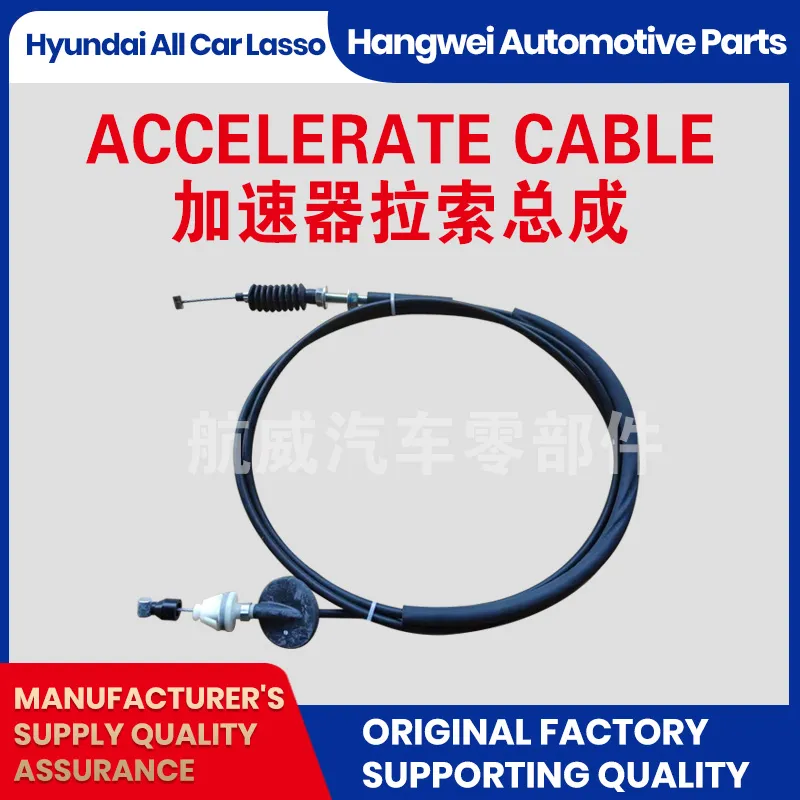Throttle Cable: Durable, Smooth Control, Universal Fit
Accelerator Push-Pull Cable: field notes, specs, and what buyers really ask
The throttle cable is not flashy, but it’s the unsung link between pedal feel and engine response. In an era obsessing over drive‑by‑wire, I still see fleets, off‑highway OEMs, marine builders, and powersports brands sticking with a mechanical solution for predictability and serviceability. And yes, I’ve walked the lines in Qinghe County—this Accelerator Push‑Pull Cable is built there (Minjiang Street south, Wuzhishan Road east), where cable makers have turned precision into a daily craft.
Trend-wise, demand is bifurcated: mass passenger cars move electronic, while commercial equipment and small engines double down on robust throttle cable assemblies with lower friction (PTFE liners), better corrosion resistance (304/316 stainless), and tighter bend radii for cramped engine bays. Honestly, pedal feel still matters; many customers say they can “feel” a good cable the moment the slack is gone.
How it’s built: materials, methods, testing
- Core wire: galvanized steel or 304/316 stainless, 7×7 or 7×19 strand for flexibility.
- Liner: PTFE or HDPE for low friction; outer conduit with PVC/TPU jacket.
- End fittings: zinc‑plated steel or brass; swaged/barrel/clevis ends depending on the pedal/throttle body.
- Manufacturing: precision cutting, swaging, crimp force monitoring, 100% stroke/drag check; optional boot seals.
- Testing: tensile pull-out, friction/drag, cycle life at temperature, salt spray (ISO 9227 / ASTM B117), UV (ISO 4892).
- Service life: around 200,000–500,000 cycles in real-world use, depending on routing and environment.

Product specs (typical build)
| Parameter | Typical value | Notes |
|---|---|---|
| Core wire | Ø1.5–2.5 mm, 7×7/7×19 SS304 | Galvanized option to reduce cost |
| Conduit OD | ≈ 6–10 mm | With PTFE or HDPE liner |
| Min bend radius | ≥ 75–120 mm | Tighter bends increase drag |
| Working temperature | −40 to +100°C (short peaks 120°C) | Jacket and liner dependent |
| Pull load capacity | ≈ 800–1500 N | Application specific |
| Compliance | IATF 16949, RoHS/REACH | Real‑world use may vary |
Where it’s used (and why it still wins)
Construction vehicles, ATVs/UTVs, go‑karts, small generators, marine throttles, and retrofits where ECU control isn’t wanted. Advantages include tactile feel, straightforward field service, and fewer electronic failure modes. A well‑routed throttle cable with sealed ends shrugs off dust and brine surprisingly well.
Real test data (sample lot)
- Tensile anchor pull-out: > 1.6 kN (avg), pass.
- Cycle life: 300,000 cycles at 80°C, R=150 mm, drag increase
- Salt spray: 240 h, red rust absent on stainless assemblies (ISO 9227).
- UV aging: 96 h per ISO 4892-2, jacket no cracking, ΔE ≤ 1.5.
Vendor snapshot (buyer’s quick view)
| Vendor | Certifications | Customization | Lead time | MOQ |
|---|---|---|---|---|
| HWEI (Qinghe) | IATF 16949, RoHS/REACH | Stroke, fittings, liners, boots, labels | ≈ 2–4 weeks | Low to medium |
| Supplier A (import) | ISO 9001 | Limited end fittings | 4–6 weeks | Medium |
| Supplier B (regional) | ISO 9001, RoHS | Custom lengths; fewer liner options | 1–3 weeks | Low |
Customization playbook
Provide pedal interface, throttle body geometry, target pull load, and routing sketch with bend radii. The team will match end fittings (ball/clevis/barrel), specify liner type, and confirm stroke and free play. For corrosive coastal duty, choose SS316 core and sealed boots. I’ve seen a forklift fleet cut pedal effort by ~18% just by switching to PTFE‑lined throttle cable assemblies and relaxing one tight bend.
Standards, compliance, and paperwork
- Quality: IATF 16949 production; PPAP on request.
- Environmental: RoHS and REACH compliant materials.
- Design reference: DIN 71986 for Bowden/control cable principles.
- Corrosion/aging: ISO 9227 / ASTM B117 salt spray; ISO 4892 UV.
Bottom line: for equipment where feel, serviceability, and durability win, a well‑engineered throttle cable is still the right call.
Authoritative citations
-
Clutch Line: Braided, Leak-Proof, OEM-Grade PerformanceNewsNov.10,2025
-
Throttle Cable: Durable, Smooth Control & Universal FitNewsNov.10,2025
-
Throttle Cable: Durable, Smooth, Universal Fit, Easy InstallNewsNov.10,2025
-
Clutch Line: Durable, Leak-Proof, OEM-Grade PerformanceNewsNov.10,2025
-
Hand Brake Cable | Custom, Universal & Trailer SolutionsNewsNov.10,2025
-
Clutch Line: High-Pressure, OEM-Fit, Corrosion-ResistantNewsNov.03,2025
